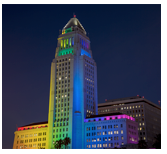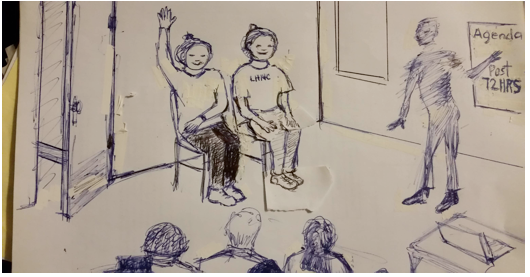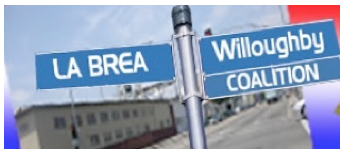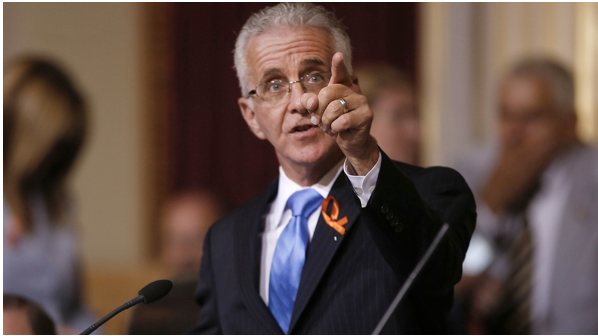EDUCATION POLITICS--Dear Professor Ta-Nehisi Coates (photo, right above): I am writing in response to an open letter that was recently addressed to you asking for your attention and admiration. It was written by the disgraced former superintendent of Los Angeles Unified School District, John Deasy. (photo, left above)
I realize, Dr. Coates, that you are not reading this article. I doubt that you read John Deasy’s either. John Deasy did not write it for you. The obsequious screed addressed to you was really for himself and the sponsors of his next “private-public” agenda: Alternative Juvenile Prisons.
So, I will address the same people whom John Deasy was addressing by similarly using you as my pseudo-conduit. (NOTE: My exploitation of your name and works is at least honest.) I hope you won’t mind being the vehicle for my Public Service Announcement.
John Deasy’s address to you was published in The 74, one of the primary voices of the extremely well-funded Education Reform Movement. Its founder, Campbell Brown, has accrued a number of Republican and wealthy Neo-Liberal Democrats to push their education agenda through its editorial advocacy. John Deasy is one of the stars of this movement.
Professor Coates, as an admirer of your landmark book and your other writings as well (hearty shout out to the new Black Panther comic!), I would like to give you an opposing viewpoint on John Deasy and provide an alternative insight into his selfish education political agenda.
First off, you should know that I taught AP English, Philosophy and Film in an LAUSD high school for over twenty years. I am a National Board Certified Teacher who uses literature and film as a way of expanding the world for my students to inform their own political and cultural consciousness. I am most proud of the fact that so many of my former students have gone on to college and adult life politically engaged, working in areas to promote social justice.
Looking back, the leadership of John Deasy at LAUSD was one of the most arrogantly destructive eras of my pedagogical lifetime. His tenure at LAUSD was marked by a raging autocratic management style where he took unilateral actions to further the corporate education agenda of Big Business -- all justified under a mask of civil rights “urgency.” Indeed “Dr.” Deasy is as adept as the Koch Brothers at appropriating the words of Dr. Martin Luther King to propel the interests of his benefactors, and in the process, his own.
This is old news for those of us in LA. But for the uninitiated: Deasy’s curriculum vitae has always defined his policies. It is a Who’s Who of America’s most powerful entrepreneurs.
John Deasy is a man who has enjoyed a whole lifetime of white privilege and the patronage of very wealthy benefactors who have assisted him in every step of his education career. Their names are familiar to all of us: Gates. Annenberg. Broad. There’s hardly a billionaire to whom John Deasy hasn’t offered his services, and been rewarded handsomely.
John Deasy first came to prominence by attending the University of Louisville graduate school of education. He was invited to study there by a professor named Robert Felner.
Deasy's and Felner's careers overlapped in Rhode Island, where Felner served as director of the University of Rhode Island's School of Education from 1996 to 2003 and Deasy served as a local school superintendent from 1996 to 2001.
A year after taking over as superintendent of the Santa Monica-Malibu Unified School District in 2001, Deasy recommended that his school system pay $125,000 for a survey performed by the National Center on Public Education and Social Policy, run by Felner. The survey was later extended for two more years at the same price, for a total of $375,000.
How long did Deasy stay at Louisville to get his doctorate? He entered the program in January, 2004 and he received his doctorate on April 9, 2004. This was unprecedented since a PhD candidate must spend two years on campus and three years is the usual amount of time it takes to get a doctorate.
Soon afterwards, in 2008, a federal grand jury indicted Felner on nine counts of mail fraud, money laundering and tax evasion. Felner siphoned away not only the $694,000 earmarked grant, but also $1.7 million in payments from three urban school districts, money that ought to have gone to the legitimate public education center that Mr. Felner had created in Rhode Island.
When Deasy left his superintendency of the small Santa Monica-Malibu School District to take over the large, predominantly black district of Prince George’s County outside Washington, D.C., he promised the search committee that he would stay between four and eight years, the length of time, Deasy assured, it would take to make a difference.
How long did John Deasy actually give to make a difference?
Nine months.
Deasy abruptly abandoned P.G. County and those students to take Bill Gates’ lucrative offer as a Deputy in his philanthropic universe, again placing his own fortunes and ambitions first.
The gig at Gates positioned Deasy to gain favor with his most ambitious benefactor, Los Angeles billionaire Eli Broad. Broad’s Superintendent’s Academy grooms private business people to take over public school systems. The graduates of this private breeding ground of public school superintendents fanned out across the country and became a virtual Who’s Who of the most aggressive and failed school CEOs of the last decade.
In a 2013 Philanthropy Magazine interview, Broad revealed that his recruiters for his Academy were former employees of Goldman Sachs. Of course John Deasy would pass that muster and become a champion for Broad’s autocratic business philosophy put into the world of education where the real needs of working class kids of color are, apparently, standardized testing, data-driven teacher evaluations, Rahm Emanuel-style autocratic neighborhood school closings and the proliferation of “public” charter schools.
John Deasy is a huge believer in executive authority promoting mayoral control over school systems and the limitless amount of dark corporate money into school board elections. His preferred candidates are vastly different to the ones I would support.
I was inspired to become a teacher by the education writings of Paolo Freire, Jonathan Kozol and Dr. Robert Coles, to name a few. None of these pedagogical intellects appear on the Eli Broad Academy syllabus. What was on the syllabus of John Deasy’s mentors? The tools for an education philosophy called “creative destruction.”
On Broad’s recommendation and his payment to fund various administrative positions of like-minded administrators (with zero input from the elected school board,) Deasy was installed as Superintendent of LAUSD in 2011. Deasy then deployed his vaunted “sense of urgency” to railroad ill-considered data-driven initiatives, top-down management directives and pedagogically improper technologies into schools, paying little heed to experienced educators in the system.
But I believe one episode best encapsulates Deasy’s executive “skills” and “passion” for social justice. Early in his tenure as superintendent, John Deasy visited a classroom on the second day of school and denigrated, shamed and humiliated a substitute teacher in front of her students. He put her in her place showing his bizarre wrath coupled with his wildly inappropriate bullying management style which would become his hallmark leadership quality. This was Deasy’s shot across the bow to everybody in the system.
There was a new sheriff.
I defy anyone to listen to teacher Patrena Shankling’s testimony of that day and not be repulsed by the inhumanity (and pedagogical or managerial “logic”) of Deasy’s actions. As teachers, we spend so much time preaching against bullying for our students and yet our top education authority uses such tactics to get his way. If one ever wanted to understand John Deasy’s manner, decorum and sense of righteous entitlement, it is all encapsulated in Shankling’s testimony.
Who became the targets of Deasy’s brave “Civil Rights” crusades?
Certainly not the power structure itself that has hurt my students in so many ways -- and neither was it the rich economic and political titans who could truly make a difference in their lives.
It was always the people below him, scapegoated, coerced, and frightened into acquiescence.
Although he has no scruples about spouting Civil Rights discourse, the true center of John Deasy’s speech is always John Deasy. He is the kind of ass who boldly says things like, “I know people say I love children too much.” Or, “People criticize me for my sense of urgency.” Or, “I will never apologize for putting children first.” Embarrassingly and like a fetish, etched into each bicep of John Deasy is a tattoo: the Chinese caricature of the word “Courage.”
I’ll leave it to a psychiatrist to examine why Deasy displayed his “courage” in extraordinary self-aggrandizement, but his narcissism is the catalyst for his public policy. Nowhere in his career does he show the vaguest understanding or respect for the grassroots organization core to the Civil Rights Movement, nor for the ability of communities to articulate their own needs and solutions. There is always ONE solution: get out of his way. This is urgent.
Because of his overreach in appropriating one billion dollars of school infrastructure bond money for a disastrous IPad program (claiming this “Civil Rights” act as the most important pedagogical necessity,) John Deasy was finally forced to leave LAUSD. The FBI seized files from his office shortly afterward and is still investigating. Deasy’s grotesque self-pity party that followed was alleviated somewhat when he was compensated handsomely for his travails by Eli Broad, subsumed again into Broad’s corporate education empire as a model for other aspiring superintendents.
It is in Education Policy where you can see the greatest split among people claiming the Progressive mantle. Rich and powerful Reform Democrats (“sigh”) find kinship with some of the most vile Republicans on what best benefits public school kids, while the educators in the actual trenches decry the abasement of education policy that provides obvious benefits to rich, business interests.
I long for a real national debate between these two camps on what is best for our nation in terms of education policy -- for all kids, but particularly the ones who both groups claim they advocate for.
John Deasy has always sided with the money.
I was gratified to hear the NAACP come out for a moratorium on charter schools, against the school closings and takeovers that have been a paramount crusade for Deasy and his corporate education advocates. The Big Business that has bankrolled the expansion of Charters throughout the country is now being more vigorously examined, particularly for which interests support them and why.
So now, the public/private education partnership that has created the Charter School Industry, that John Deasy and the Neo-Liberals have long advocated, have set their sights on a new fortune to be made: juvenile justice “reform.”
Thus, Deasy’s fawning letter to you, Dr. Coates. Each side of the Progressive Education debate sees the crucial value in a Black Lives Matter endorsement. Appropriating the mantel of Civil Rights is the cornerstone of Deasy’s self-righteous strategy. If the NAACP is pulling out of corporate education reform, perhaps corporate justice reform will appeal to BLM?
John Deasy rests comfortably among the 1%, who he claims are the ones who can truly deliver on the promise of Civil Rights.
This is what John Deasy believes and I do not doubt his passion. He honestly believes that he is what kids of color need. But John Deasy’s pedagogy and activism are the opposite of what is required. He doesn’t put his faith in the democratic system -- he puts his faith in wealth to deliver the same Top Down change that fails to acknowledge how this oppression is what these communities are seeking to not only remedy, but to flee from.
In summary: Narcissistic Bully + Billionaire Backers + Self-righteous White Savior Complex = BEWARE.
But of course you knew that: it’s one of the great themes of your work.
John Deasy and his allies are the epitome of the World Between so many of us.
(Joshua Leibner taught in LAUSD public schools for 20 years. He is a National Board Certified teacher. This piece first appeared on LAProgressive.com.) Prepped for CityWatch by Linda Abrams.



 California has also become the first state to protect people from being charged with being a sex worker solely on the basis that they are carrying condoms. Because of the large number of transgender women who have turned to sex work over the years due to discrimination and destitution, women are being profiled by law enforcement and arrested for carrying protection. This law requires the court to state without a doubt that the condoms are relevant to a particular case in order to be used as evidence.
California has also become the first state to protect people from being charged with being a sex worker solely on the basis that they are carrying condoms. Because of the large number of transgender women who have turned to sex work over the years due to discrimination and destitution, women are being profiled by law enforcement and arrested for carrying protection. This law requires the court to state without a doubt that the condoms are relevant to a particular case in order to be used as evidence. 







 Now one has to wonder if that City Hall backing will result with LA getting not just one sinking and tilting skyscraper but two!
Now one has to wonder if that City Hall backing will result with LA getting not just one sinking and tilting skyscraper but two!
 It’s Hot Out: It can’t have escaped anyone’s notice that temperatures in the northern hemisphere peak during summertime. And we live in a desert where the effort to control indoor climate is especially resource-intensive and hard to justify.
It’s Hot Out: It can’t have escaped anyone’s notice that temperatures in the northern hemisphere peak during summertime. And we live in a desert where the effort to control indoor climate is especially resource-intensive and hard to justify. 

 The La Brea Willoughby Coalition (“LCW”) neighborhood is a microcosm of these dynamics. Four SLS projects proposed and approved within a one-block area resulted in loss of affordable rent-control units on all project lots. The projects also resulted in several appeals and two lawsuits in which LWC prevailed.
The La Brea Willoughby Coalition (“LCW”) neighborhood is a microcosm of these dynamics. Four SLS projects proposed and approved within a one-block area resulted in loss of affordable rent-control units on all project lots. The projects also resulted in several appeals and two lawsuits in which LWC prevailed. 







 Criminals, however, do not care who owns property. It can be you, it can be me, or it can even be the State of California. When a criminal syndicate operates with the force of law, they take whatever they need. And, everyone else better shut up or else.
Criminals, however, do not care who owns property. It can be you, it can be me, or it can even be the State of California. When a criminal syndicate operates with the force of law, they take whatever they need. And, everyone else better shut up or else. 














